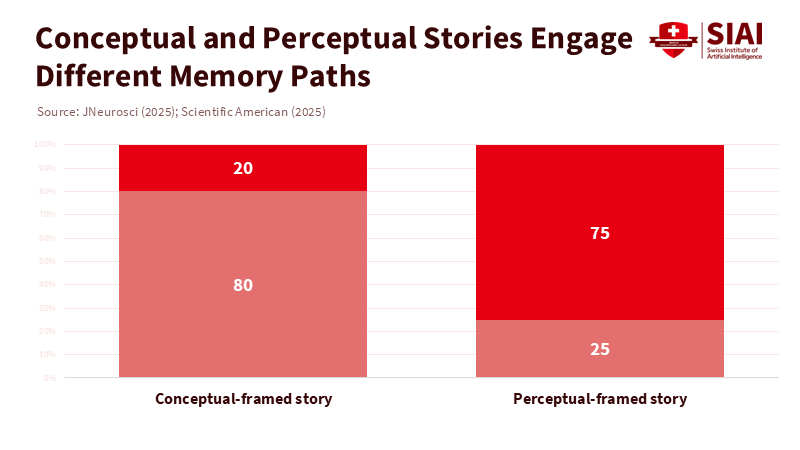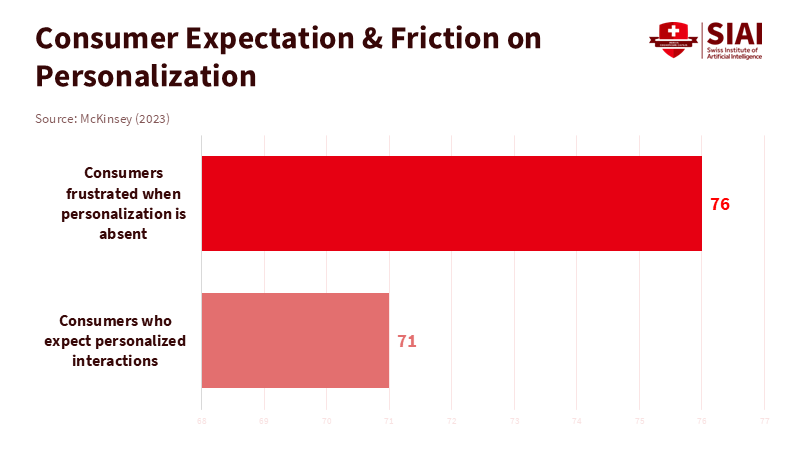Narrative Personalization: Match Minds, Not Just Segments
Input
Modified
Stories stick differently: meaning-first vs. detail-first brains Match the frame—narrative personalization—to each audience’s memory mode Expect stronger recall and 30–40% gains; measure retention and transfer

Suppose one statistic should change how we teach, market, and design AI responses. In that case, effective personalization can boost conversion and cross-sell rates by about 30% to 40%. That is not a minor adjustment; it is a change that affects whether a course fills up, a product sells, or a guidance counselor connects with the right student at the right time. Yet much of what we call personalization is superficial: a first name in an email, a dynamic banner, or a nudge sent at 9:02 a.m. The real value lies in understanding the mind. A 2025 neuroimaging study shows that the same story, told with different details, is stored in other memory networks. These networks influence how well people recall the core of that story later. In simpler terms, a message presented one way may resonate with some audiences while falling flat for others. This is the essence of narrative personalization, where measurable benefits exist. For instance, in marketing, it could mean tailoring a product story to match the emotional needs of different customer segments. In education, it could involve presenting a lesson in two different ways to cater to students who prefer conceptual understanding and those who like detailed steps.
Why narrative personalization is a different approach
Most personalization systems focus on deciding who sees what and when. Narrative personalization adds the element of how. It begins with a fundamental truth about memory: some people prefer the overall idea—goals, causes, "what it means"—while others lean toward specific details—images, steps, "what it looks like." In the 2025 brain study, stories rich in emotions and interpretations activated the default-mode network and led to greater confidence. On the other hand, stories filled with sensory details activated regions responsible for reconstructing sights and sounds. Recall of the same key events depended on which type of information a listener favored. This does not imply one style is better than the other. It highlights the importance of alignment: using the right detail for the right mind. Personalization that overlooks this alignment misses out on value and muddies brand and learning outcomes.
Narrative personalization is distinct from the "simplify" advice related to processing fluency. Research on fluency reveals that when information is easier to process, people tend to prefer it more and connect with brands faster. New findings even link easier-to-process names and logos to stronger brand connections. Yet fluency encompasses more than just smooth typography or familiar words. It has a conceptual side (the idea fits my understanding) and a perceptual side (the stimulus looks and sounds easy). When we tailor our narrative to match the audience's preferred way of thinking—conceptual or perceptual—we enhance fluency where it matters most. This serves as the bridge from lab evidence to practical strategy, applicable to classroom design, admissions communications, product storytelling, and the tone of AI answers.

What memory science reveals about narrative personalization
The new evidence is clear: when listeners focus on stories built around interpretations and emotions, brain activity in the hippocampus connects with a default-mode network attuned to self and meaning. When they concentrate on stories heavy with external, concrete details, hippocampal activity is aligned with parts of the brain responsible for assembling sensory information. This pattern is significant: those brain signatures could predict how well a person recalled the main elements of the story later. Importantly, overall recall accuracy between the two types was similar in the short term; the difference lay in the path taken and the confidence people felt. This suggests that segmenting by memory pathway, rather than just by demographics or devices, can improve outcomes without altering the core facts. For marketers, this means one offer can take two forms. For educators, the same lesson can be engaged with through two different approaches.
Decades of consumer research support this mechanism. Previous studies show that fluent processing leads to a mild, positive feeling and speeds up judgment. Fluency consists of two parts. Perceptual fluency (clear visuals, easy-to-pronounce names, simple layouts) enhances ease and recall in some situations. Conceptual fluency (alignment of message and meaning, clarity of ideas, coherence of narrative) fosters connection. It encourages action, especially when people are considering identity or goals. A 2024 series of studies indicates that easier-to-process names and repeated exposure to logos can enhance self-brand connection, which is crucial for choice and loyalty. The message is straightforward: if your audience is more conceptual, make the meaning feel effortless and concise; if they are more perceptual, make the stimulus feel easy and vibrant. Narrative personalization focuses on the right lever first.
From brain to brand (and bots): strategy for narrative personalization
If narrative personalization is effective, it should reflect in the results. And it does. Across various sectors, better-matched experiences yield improvements of 30% to 40% in conversion and cross-sell rates. Meanwhile, many consumers express a preference for brands that offer personalized experiences and report spending more with them. A significant number of retailers, however, overestimate the quality of their personalization methods. The gap between teams' perceptions of their delivery and what people actually feel is where narrative fit comes into play. Narrative fit refers to the alignment of the narrative with the preferred cognitive style of the audience. Begin by treating conceptual and perceptual versions as core creative elements rather than afterthoughts. Every campaign should have two versions: one that focuses on 'why this matters' and another that emphasizes 'what it looks like/how it works.' Allow your targeting and measurement to determine which approach resonates with different audiences at various stages.

The shift to AI makes this approach even more critical. As search evolves with large language models summarizing, answering, and making recommendations, some brands are noticing significant drops in clicks due to "zero-click" results. The way your narrative appears in model outputs influences discovery. This does not eliminate brand building; it raises expectations. Your story needs to engage both humans and machines. For machines, organize your content to highlight key claims, supporting evidence, and entry points clearly and consistently. For humans, maintain an emotional arc and clarity that keeps their attention. Consider your narrative as dual-purpose data: a resource for memory and a benefit for models. Generative engine optimization is not just a trend; it encourages a focus on what your brand represents and how that message travels across channels and formats.
Implementing narrative personalization is straightforward. Create a simple classifier based on existing signals. Individuals who respond to before-and-after images, specifications, or how-to videos likely prefer perceptual framing. Those who connect with founder stories, mission statements, or outcomes likely prefer conceptual framing. Use small A/B tests to verify your assumptions. Then allow the system to lead with each message type: conceptual first for conceptual minds, perceptual first for perceptual minds. Keep the facts consistent. This approach maintains brand consistency while helping each audience remember the core message more effectively. For governance, develop a one-page "narrative playbook" outlining the two modes for your brand, including verbs, motifs, types of evidence, and preferred formats in each category. This playbook ensures designers, writers, and AI prompts stay aligned.
Large language model responses should adhere to the same principle. A bank's chatbot might present the same mortgage offer in two styles: conceptual first ("Here's how this product supports your goal and reduces risk over time") versus perceptual first ("Here is the step-by-step with fees, timelines, and a calculator"). An educational platform can offer two brief explanations for the same physics concept: one that introduces the idea and its real-world significance, and another that begins with diagrams and a worked example. Over time, the assistant can learn which approach helps users answer and retain information better. This is narrative personalization at work—no added discounts, no tricks, just a more effective entry point to the duplicate content.
What narrative personalization means for classrooms and policy
Education faces a memory challenge before it encounters a motivation issue. Students often know about a topic but struggle to recall it when test questions vary. Narrative personalization offers teachers and designers a way to respect evidence and lessen friction. In courses that rely heavily on symbols and procedures, many students require conceptual context to anchor their practice. In contrast, others need concrete cues to grasp ideas. Design each unit with two parallel entry points. One should start with the "why" narrative, presenting a brief cause-and-effect framework and a real-world example. The other should begin with a vivid illustration, a diagram, or a sequence of steps. Keep the core learning objectives and assessments the same. Measure not only quiz scores but also transfer: can students apply the idea in a different context a week later? Research indicates that other paths can solidify the same concept more effectively for various learners.
Administrators can implement narrative personalization in communications as well. Admissions pages and financial aid guidance should present two perspectives on the same information. Lead with purpose, outcomes, and social proof for conceptual readers; lead with timelines, checklists, and calculators for perceptual readers. Use analytics to determine which version performs better for each audience segment at different stages in the process. On the policy side, procurement guidelines for learning platforms should ensure that AI tutors are designed to support multiple narrative modes, rather than just serving as a selectable "tone." Standards organizations can encourage this by asking vendors how they assess and report retention and transfer for students with different narrative preferences, beyond mere click-through or time-on-task metrics. In simple terms: prioritize fit, not flash.
Anticipate resistance. Critics may claim this is merely a rebranding of "learning styles," a theory that failed to show benefits when styles were treated as fixed labels. Narrative personalization differs in two key ways. First, it relies on task-dependent memory systems that can be observed and that predict how well shared core content is recalled. Second, it does not alter what is taught. It shifts how the story is introduced and which details are emphasized while keeping the facts, practice, and assessments constant. This maintains rigor and avoids the issue of teaching different content to different students. The same logic applies in marketing: one truth, two paths.
For public funders and policymakers, the immediate opportunity lies in measurement—pilot narrative personalization in national tutoring or adult-learning programs with a straightforward design. Randomly assign learners to conceptual-first or perceptual-first introductions for modules in math, language, and health. Monitor delayed recall and problem transfer after one and four weeks. Publish the results regardless of the outcomes. The benchmarks for policy should be transparent, cost-effective, and replicable. If gains are found in one area or age group, scale those approaches where they succeed; discontinue those that do not. If the results are mixed, use the data to understand who benefits and where. Regardless, the process is worth the investment: minimal tooling changes, significant potential rewards.
The argument for narrative personalization is not a request for more content. It is a call to reframe existing content so that it resonates within the memory systems people already use. We understand that effective personalization can yield improvements of 30% to 40%. We also know that telling the same story with the correct details can activate the appropriate brain network and boost the recall of core facts. In a landscape where large language models respond first and audiences engage second, the successful will craft narratives for both minds and machines. This does not necessitate a revolution in platforms. It calls for a disciplined approach: switch the narrative lead, maintain truth, and measure what really matters: whether people remember and take action. Start with one module, one campaign, one chatbot interaction. Create two ways in. Keep the interior consistent. Then let the data reveal which entry point each audience prefers, and guide them through it.
The views expressed in this article are those of the author(s) and do not necessarily reflect the official position of the Swiss Institute of Artificial Intelligence (SIAI) or its affiliates.
References
Boston Consulting Group (2024). What Consumers Want from Personalization. Conversion and cross-sell gains of 30%–40%.
Deloitte (2024). Personalization Strategy in Retail Media. 80% of consumers prefer personalized experiences; higher spend; perception gap with retailers.
DelVecchio, D., Jones, W. J., & Baugh, L. (2024). From easy to known: How fluent brand processing fosters self-brand connection. Psychology & Marketing.
McKinsey & Company (2025). Unlocking the next frontier of personalized marketing. Role of AI and genAI in scaling personalization.
Marketing Week (2025). Roach, T. Winning hearts, minds and models: Brand building in an AI world. GEO, zero-click behavior, LLM visibility.
Schwarz, N., et al. (2023). Metacognitive experiences as information: Processing fluency in judgment and decision making. Review of fluency effects.
Society for Neuroscience / JNeurosci (2025). Hippocampal–Cortical Networks Predict Conceptual Versus Perceptually Guided Narrative Memory. News release summarizing neuroimaging findings.
Scientific American (2025). "Brains Remember Stories Differently Based on How They Were Told." Report on the same study with additional context on network differences and confidence.





















